
This page created 1 January, 2003 and last modified: 12 September 2015 (Victores iuniores Britanniciani commentary updated)

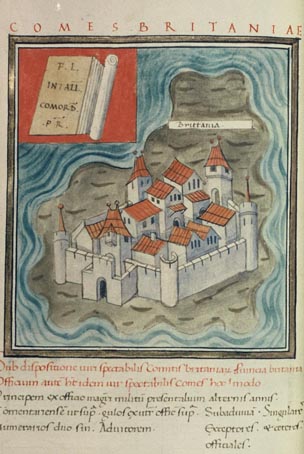 |
The following infantry units are listed as being under the command of the Count of Britain, said to be drawn from those under the overall command of the Magister Peditum:
102/5.206 Victores iuniores Britanniciani 102/5.207 Primani iunioresalong with the following cavalry units, said to be drawn from those under the overall command of the Magister Equitum:
102/5.251 Equites catafractarii iuniores Note that unlike the other British Count, the Comes litoris Saxonici per Britanniam, the command of Comes Britanniae is not listed with any associated forts or towns; his command is represented in the frontpiece to the left as one large 'town' called 'Britannia'; in this he is similar to the Comes Italiae and the Comes Argentoratensis; however, neither of these latter commands have troops associated with them, unlike that of the British Count. |
Seeck identified the Victores iuniores Britanniciani with the Victores iuniores, an auxilia palatinae unit (98/9.60) that is actually listed (102/5.178) as being in Spain. At least two other reasonable possibilities exist, however. The first is an equation with the Exculcatores iuniores Britanniciani, which is listed (98/9.82) as being among the units under the overall command of the Magister Peditum, but which is not otherwise assigned to any of the various armies of the Duces, Comites, or Magistri. Even more likely, however, is a simple non-identification with any of the units listed in the Magister Peditum's infantry roster. The unit may have been destroyed before the final emendation of the Notitia, and thus deleted from the roster, for example.
The Secundani iuniores would appear to be the Legio Secunda Britannica siue Secundani of the Magister Peditum's list, a legiones comitatenses unit (98/9.115) that is also listed as being in Gallia, where it is called the Secundani Britones (98/9.136). This certainly seems more likely than the other units with 'Secund...' in their name, in that they are all accounted for, and do not have 'Brit...' in their name. If the Secundani Britones is not the Secundani iuniores listed above, then this unit must also remain a mystery. The principle of Occam's razor would suggest they are one and the same. Further, this unit is obviously the same as (or a detachment of) the Legionis secundae Augustae under the command (132.8) of Comes litoris Saxonici per Britanniam.
The Primani iuniores seems to be unaccounted for. Regarding Gallic units with "Prima" as part of their names, Seeck identified the comitatenses unit the Prima Flavia (102/5.147) of the Gallic command with the Prima Flavia Metis (98/9.143) on the reasonable basis that the other Prima Flavia in the Gallic command, the Prima Flavia Gallicana (102/5.142), is the Prima Flavia Gallicana Constantia (98/9.138, Constantia being a town in Armorica where one units was stationed and Metis being a town in Belgicae secundae where the other unit was undoubtably similarly stationed in the recent past). The Primani iuniores is therefore unlikely to be either of these two units, since they have immediate origins on the continent. It remains a mystery, but see the discussion under the Dux Thebaidos about the possibility it is (part of) the old Sixth Legion once stationed at York. Another possibility is the Primani iuniores is the remnant of not Legio VI but yet another Legio I. Since at least 1923 it has been suggested (E.C.Nischer, available here or here) that both a Legio I Flavia Victrix and a Legio I Flavia Constantina should have been raised during the Tetrarchy to fill perceived gaps in the numbering of the legions in the Notitia; the first stationed in Britain, and the latter in Africa. If so, then a Legio I Flavia Victrix could correspond, in part, to the Flavia victrix Constantina (id est Constantici) of the Magister Peditum's infantry roster (98/9.126), having been brought over to the continent at some stage, possibly by Constantine I himself. It could also, by virtue of its number, correspond, in part, to the Primani iuniores, which would then likely be a portion of the same old legion that had been left behind, in much the same way as Constantine is known to have taken detachments of other legions to form his field army during his civil war campaigns - e.g. the Divitenses seniores (98/9.023) from Legio II Italica. In any case, no matter the origins of the Primani iuniores, there must have been a Primani seniores to match it; but the Notitia records no such unit. Perhaps the Primani (12.19) of the Magister Militum Praesentalis II is to be equated with the missing Primani seniores.
It can thus be seen that the identities of the infantry units under the command of the Comes are soemwhat uncertain; this extends to the cavalry as well: despite the list claiming the cavalry units are drawn from those under the Magister Equitum, in fact only one of the six, the Equites Honoriani seniores, is clearly so listed (102/5.19), as a vexillationes comitatenses unit. A unit with this particular name is also listed as being in Gallia (102/5.222) as well as in Britain; they are likely one and the same. The other five units are less easy to identify.
While the Equites catafractarii iuniores is not listed as being under the command of the Magister Equitum, the Dux Britanniorum however does list (154.7) a prefect commanding a unit of Equites catafractarii, so the presence in Britain of such a unit seems solid enough; they seem to have been drafted into the field army of the Comes Britanniae at some time by withdrawing them from their usual garrison position.
There are two Equites stablisiani units listed under the Magister Equitum, both listed as being stationed in Africa: the Equites stablesiani Italiciani (102/5.231) and the Equites stablesiani (Africani) seniores (102/5.233). This British Equites stablisiani unit might possibly be one of these two, but it is much more likely to be the men under the command of the Praepositus equitum stablesianorum Gariannonensium, listed under the Comes litoris Saxonici per Britanniam, and drafted into the field army of the Comes Britanniarum in the same way as the Equites catafractarii iuniores.
Similarly the Equites scutarii Aureliaci would appear to be the same unit as the men under the Praefectus numeri Maurorum Aurelianorum, a limitanei unit (154.30) under the Dux Britanniarum, whose full name from epigraphic evidence (RIB 2042), dated to 253-258 AD from Burgh-by-Sands, is the N MAUR[.]RUM AUR VALERIANI GALLIENIQ, which expands to the "N(umerus) Maur[o]rum Aur(elianorum) Valeriani Gallieniq(ue)". There is nothing about the word 'numerus' that signifies legionary or non-legionary, foot or horse; it just means 'a number/collection (of troops)'. Gallienus constituted many units of cavalry in the 250s; this is presumably one of them. Burgh-by-Sands is Aballaba, the very same place the Notitia assigns the Praefectus numeri Maurorum Aurelianorum. However, it is worth noting that there is inscriptional (AE 1977, 8182) plus tile-stamp (see this paper by Hartmann & Spiedel) evidence for a possible Equites scutarii Aureliaci in Zuegma on the Euphrates in the 4th century. This could be a different unit with the same name; it could be the same unit moved out of Britain all the way to Syria and moved back again (unlikely, one would imagine); or it could be original of the British Equites scutarii Aureliaci, in which case it would not be the same unit as the Numerus Maurorum Aurelianorum (Aurelianum was what is now modern Orleans in France, refounded by the Emperor Aurelian in 273/4, so the unit might have been recruited from there, or stationed there at some point).
The Equites Syri are somewhat of an enigma, as again no such unit is listed as being under the Magister Equitum's cavalry roster; they might well be one of the units listed under the Dux Britanniarum. A now lost alter (RIB 764) from Kirkby Thore (Barboniaco in the Notitia, where the Praefectus numeri defensorum is stationed under the Dux Britanniarum) might attest (according to one reconstruction of the text) to a N[umerus] M[ilitum] S[yorum] S[agittariorum]; horse archers seem likely enough for a Syrian unit, although it is hard to see a unit of sagittarii in the cavalry units listed under the two British limitanei commanders and described as equites; accordingly they could well be one of the alae, but again, which one is hard to make out. Perhaps they are instead the men under the Praefectus numeri barcariorum Tigrisiensium. The origin of this unit (meaning the "Tigris bargemen") is clearly from the Tigris river, which was not normally accounted as being part of Roman Syria, but this was usually because the Roman border stopped at the Euphrates, and did not normally extend as far as the Tigris. However, it is difficult to see a unit of boatmen being equated with horse archers (any kind of or cavalrymen for that matter), and it may be that the Equites Syri have nothing to do with horse archers, as the enigmatic "NMSS" can easily be expanded in many other ways that do not mention either Syria or sagittarii, in which case they could easily be any of a number of the equites or alae units mentioned under the Dux. A 3rd century inscription (RIB 780, image here) from Brovacum (Brougham) records a N(umerus) EQQ [St]RATONICIANORUM which might well refer to what is the Equites Syri in the Notitia, since Stratonice is a common location name in ancient Syria (the most famous Stratonice being Antiochus Soter's wife, but the name was given to many women of the Seleucid dynasty, for whom places were subsequently named after).
The Equites Taifali could possibly be another of the units listed under the Dux Britanniarum; however, there is apparently no epigraphic evidence for any Taifalian units in Britain it seems. The unit is probably the same as the Equites Honoriani (Taifali) iuniores listed (102/5.223) as being under the Magister Equitum's command in Gallia. Nonetheless, evidence for the unit in Britain may be found in the name of the village Tealby, formerly Teflesbi, adjacent to the site of a Roman town at what is now Ludford on the road northeastwards from Lincoln, the provincial capital (Lindum), and where three sets of late Roman cavalry spurs have been found. See Thomas Green: Tealby, the Taifali, and the end of Roman Lincolnshire (2011), available here.
The section describing the Comes Britanniarum is thus rather confusing. Jones (Vol. III, appendix II, page 354) concluded that because some of the same units appeared to be listed under both the Gallic army and under the Comes Britanniae, the Comes Britannie was a recent establishment, post 418 AD, with the British units being taken from the Gallic army. However, as it can be seen above that some of the units in the Magister Equitum's Gallic command come from the British limitanei garrisons under the Dux Britanniarum and the Comes litoris Saxonici per Britanniam, this would require that these units be sent first to Gaul and then back to Britain again. This is also something that is not hinted at in any literary source outside the Notitia, which, when they mention British troops at all, have Britain being denuded of troops, not reinforced. Thus it seems to me that the opposite conclusion is much the more preferable: the troops were withdrawn from the British limitanei into a British comital army - that under the Comes Britanniarum, and then subsequently incorporated into the Gallic army.
This conclusion is buttressed by the arrangement of the chapters in the Notitia - see Ingo Maier's commentary at page 13, here. The command of the Comes Britanniae thus would appear to be an interim creation; neither in existence when the Notitia was first compiled, i.e. the 390s, nor extent when the Notitia was last updated ca. 420 AD.
The following shield patterns can therefore be taken from those given under the Magister Peditum and the Magister Equitum, using the patterns taken from the Paris manuscript:
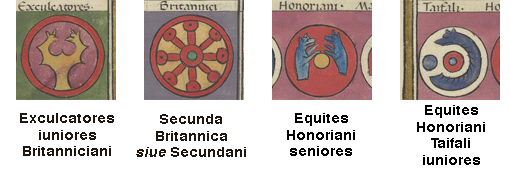
For completeness, below are the corresponding frontpieces for the Comes Britanniae taken from the Parisian manuscript (O, left) and the second part of the Munich manuscript (W, right).
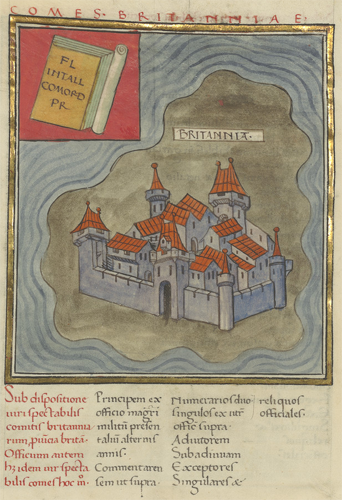
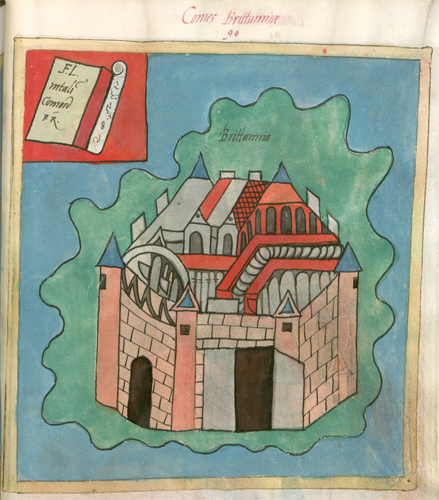
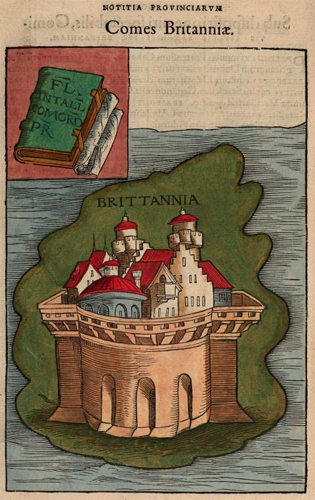
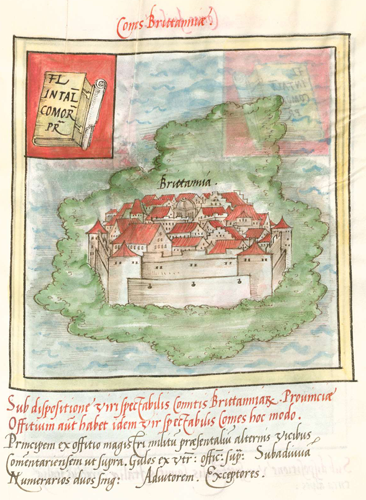

Return to the Notitia index page.